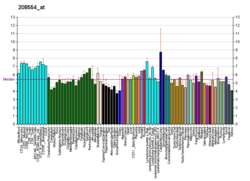POU4F3
Appearance
POU domain, class 4, transcription factor 3 is a protein that in humans is encoded by the POU4F3 gene.[5][6] It's a member of BRN-3 group, also known as POU family class 4.
Nomenclature
DFNA15 refers to a type of nonsyndromic deafness, with autosomal dominant inheritance.
References
- ^ a b c GRCh38: Ensembl release 89: ENSG00000091010 – Ensembl, May 2017
- ^ a b c GRCm38: Ensembl release 89: ENSMUSG00000024497 – Ensembl, May 2017
- ^ "Human PubMed Reference:". National Center for Biotechnology Information, U.S. National Library of Medicine.
- ^ "Mouse PubMed Reference:". National Center for Biotechnology Information, U.S. National Library of Medicine.
- ^ Vahava O, Morell R, Lynch ED, Weiss S, Kagan ME, Ahituv N, Morrow JE, Lee MK, Skvorak AB, Morton CC, Blumenfeld A, Frydman M, Friedman TB, King MC, Avraham KB (Apr 1998). "Mutation in transcription factor POU4F3 associated with inherited progressive hearing loss in humans". Science. 279 (5358): 1950–4. doi:10.1126/science.279.5358.1950. PMID 9506947. S2CID 25291858.
- ^ "Entrez Gene: POU4F3 POU domain, class 4, transcription factor 3".
Further reading
In Vivo Interplay between p27Kip1, GATA3, ATOH1, and POU4F3 Converts Non-sensory Cells to Hair Cells in Adult Mice
- Nolan LS, Jagutpal SS, Cadge BA, et al. (2017). "Identification and functional analysis of common sequence variants in the DFNA15 gene, Brn-3c". Gene. 400 (1–2): 89–97. doi:10.1016/j.gene.2007.05.023. PMID 17611044.
- Gerhard DS, Wagner L, Feingold EA, et al. (2004). "The Status, Quality, and Expansion of the NIH Full-Length cDNA Project: The Mammalian Gene Collection (MGC)". Genome Res. 14 (10B): 2121–7. doi:10.1101/gr.2596504. PMC 528928. PMID 15489334.
- Clough RL, Sud R, Davis-Silberman N, et al. (2004). "Brn-3c (POU4F3) regulates BDNF and NT-3 promoter activity". Biochem. Biophys. Res. Commun. 324 (1): 372–81. doi:10.1016/j.bbrc.2004.09.074. PMID 15465029.
- Weiss S, Gottfried I, Mayrose I, et al. (2003). "The DFNA15 Deafness Mutation Affects POU4F3 Protein Stability, Localization, and Transcriptional Activity". Mol. Cell. Biol. 23 (22): 7957–64. doi:10.1128/MCB.23.22.7957-7964.2003. PMC 262385. PMID 14585957.
- Strausberg RL, Feingold EA, Grouse LH, et al. (2003). "Generation and initial analysis of more than 15,000 full-length human and mouse cDNA sequences". Proc. Natl. Acad. Sci. U.S.A. 99 (26): 16899–903. Bibcode:2002PNAS...9916899M. doi:10.1073/pnas.242603899. PMC 139241. PMID 12477932.
- Leonard JH, Cook AL, Van Gele M, et al. (2002). "Proneural and proneuroendocrine transcription factor expression in cutaneous mechanoreceptor (Merkel) cells and Merkel cell carcinoma". Int. J. Cancer. 101 (2): 103–10. doi:10.1002/ijc.10554. PMID 12209986. S2CID 20592545.
- Erkman L, McEvilly RJ, Luo L, et al. (1996). "Role of transcription factors Brn-3.1 and Brn-3.2 in auditory and visual system development". Nature. 381 (6583): 603–6. doi:10.1038/381603a0. PMID 8637595. S2CID 37343529.
- Xiang M, Zhou L, Macke JP, et al. (1995). "The Brn-3 family of POU-domain factors: primary structure, binding specificity, and expression in subsets of retinal ganglion cells and somatosensory neurons". J. Neurosci. 15 (7 Pt 1): 4762–85. doi:10.1523/JNEUROSCI.15-07-04762.1995. PMC 6577904. PMID 7623109.
External links
- POU4F3+protein,+human at the U.S. National Library of Medicine Medical Subject Headings (MeSH)
This article incorporates text from the United States National Library of Medicine, which is in the public domain.





